| |
|
|
36.
| Modern Times, A History of the Machine |
| |

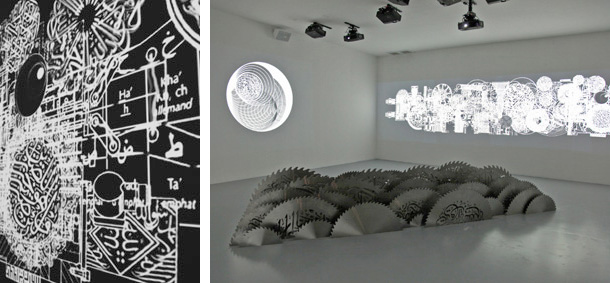
2009-2010, videos, sound, saw blades in steel.
Exhibition view of Told, Untold, Retold, Mathaf Arab Museum of Modern Art, 2010, Doha.
Courtesy of the artist and Art Front Gallery, Tokyo.
Ed. of 1 + 1 A.P.
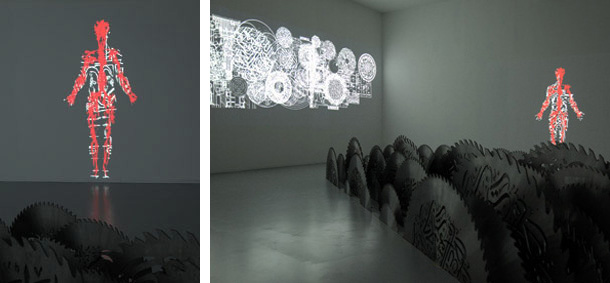
2009-2010, videos, sound, saw blades in steel.
Exhibition view of Told, Untold, Retold, Mathaf Arab Museum of Modern Art, 2010, Doha.
Courtesy of the artist and Art Front Gallery, Tokyo.
Ed. of 1 + 1 A.P.
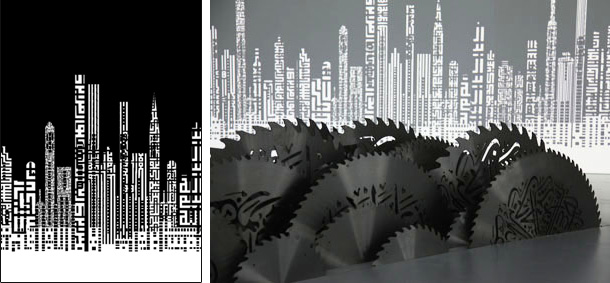
2009-2010, videos, sound, saw blades in steel.
Exhibition view of Told, Untold, Retold, Mathaf Arab Museum of Modern Art, 2010, Doha.
Courtesy of the artist and Art Front Gallery, Tokyo.
Ed. of 1 + 1 A.P.
 Video Video
'' Speed and motion both play an important role in “Modern Times”. As early Arab astronomers observed the movement of stars and planets,
mounir fatmi observes the shape of today's world and the, often erratic, motion of global contemporary society. ''
Caroline Rossiter, March 2008
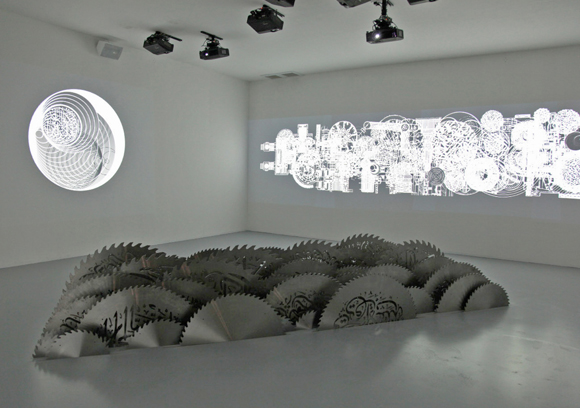
Modern Times
Exhibition view of Told, Untold, Retold, Mathaf Arab Museum of Modern Art, 2010, Doha.
Courtesy of the artist and Art Front Gallery, Tokyo.
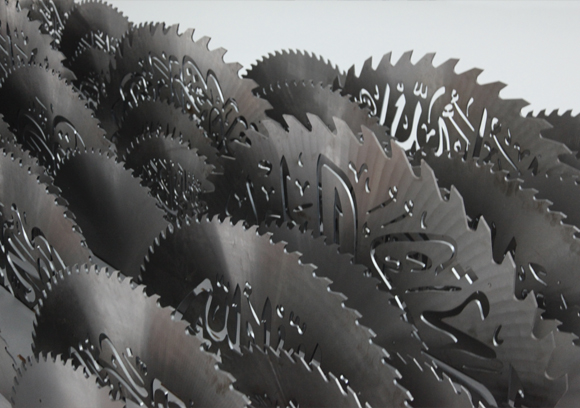
Modern Times
Exhibition view of Told, Untold, Retold, Mathaf Arab Museum of Modern Art, 2010, Doha.
Courtesy of the artist and Art Front Gallery, Tokyo.
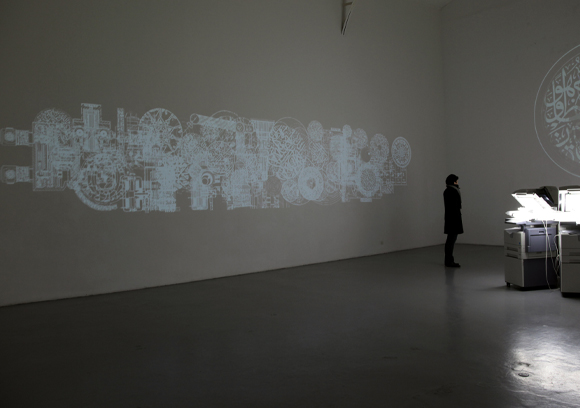
Modern Times
Exhibition view of Between the lines, Galerie Hussenot, 2011, Paris.
Courtesy of the artist and Art Front Gallery, Tokyo.
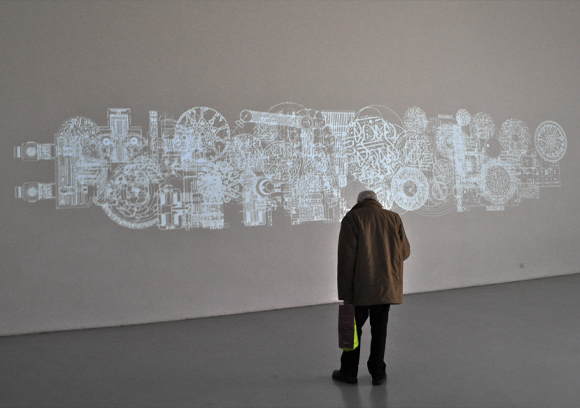
Modern Times
Exhibition view of Between the lines, Galerie Hussenot, 2011, Paris.
Courtesy of the artist and Art Front Gallery, Tokyo.
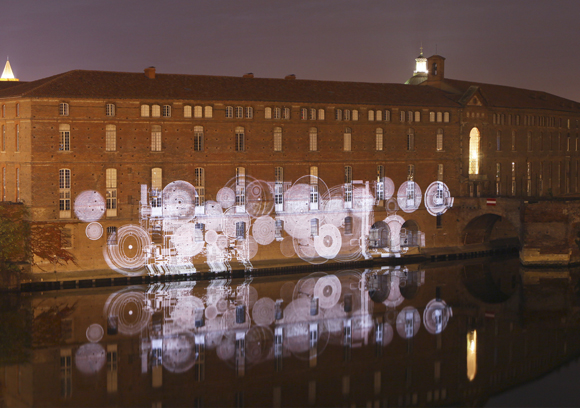
Modern Times
Exhibition view of Printemps de Septembre, 2012, Toulouse.
Courtesy of the artist and Art Front Gallery, Tokyo.
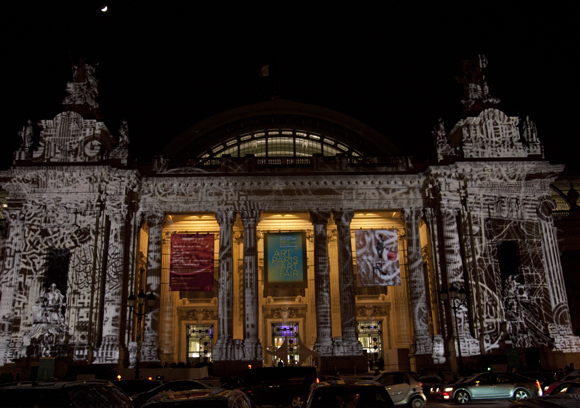
Modern Times
Exhibition view of Art Paris, Grand Palais, 2015, Paris.
Courtesy of the artist and Art Front Gallery, Tokyo.
|
|
|
|
|
| Collection of Mathaf, Modern Arab Art Museum, Doha
This work was part of 6th Manif d'art Biennial -Machines - Les Formes du mouvement, Québec, 2012.
This work was part of 3rd Thessaloniki Biennale - A Rock and a Hard Place, Thessaloniki, 2011.
|
"Les Temps modernes » est une œuvre qui enveloppe le spectateur. Au milieu de la salle, un ensemble sculptural forme une pièce à la fois délicate et menaçante. Une série de scies circulaires à ruban sur lesquelles on peut voir des calligraphies arabes sont suspendues, évoquant un système d’engrenages ou une boîte de vitesses. Des images projetées sur le mur autour de la sculpture montrent des constructions architecturales au Moyen Orient, créant un environnement cinématographie intense. Le titre de l’œuvre, « Les Temps modernes », s’inspire du célèbre film de Charlie Chaplin de 1936, dans lequel Chaplin incarne un ouvrier en détresse dans une ligne production à la chaîne. La modernité des machines de l’usine est visuellement représentée par une série d’engrenages vrombissants. Des scènes comiques montrent Chaplin se faisant dévorer par la machine, mais ces images suggèrent une réalité plus sombre : l’aliénation de l’homme dans la société moderne industrialisée. L’ouvrier en usine est avalé par la machine avec laquelle il ne peut plus rivaliser.
Dans ses « Temps modernes », Mounir Fatmi s’intéresse à cette modernité née au XIXe siècle en Occident. La rapidité de l’industrialisation et la croissance des villes sont reflétées aujourd’hui dans le développement rapide de l’urbanisation du Moyen Orient. Des villes apparaissent dans le désert, avec des immeubles construits si rapidement qu’il ne reste plus aucun temps pour réfléchir à ces changements. Ce lien mental entre industrialisation occidentale et développement récent en Orient se manifeste dans « Les Temps modernes » à travers les interactions entre les différents éléments de l’installation.
Les lames circulaires en forme d’engrenages sont décorées de calligraphies arabes, un motif récurrent dans l’œuvre de Mounir Fatmi. Dans « Les Temps modernes », la calligraphie est découpée dans le métal comme un stencil, au lieu d’être inscrite sur les lames. Cette inscription en négatif permet une interaction entre les lames et les projections, créant un sentiment d’ambiguïté, les courbes et arabesques de la calligraphie éclipsant la signification des mots, comme si le message disparaissait dans le moteur de la machine. Les mots sont ravivés d’une façon purement visuelle en tant que formes circulaires abstraites, reflétant le mouvement circulaire de l’installation.
Ces formes circulaires sont aussi un clin d’œil aux peintres modernistes Sonia et Robert Delauney et Fernand Léger. La répétition de formes circulaires et géométriques dans leurs peintures était une façon d’essayer de décrire le monde moderne, tout comme l’installation de Mounir Fatmi est une façon d’en découdre avec le mouvement continu et apparemment sans fin de la production et de la consommation au XXIe siècle.
La vitesse et le mouvement jouent tous deux un rôle important dans « Les Temps modernes ». Tout comme les premiers astronomes arabes ont observé le mouvement des astres et des planètes, Mounir Fatmi observe la forme du monde d’aujourd’hui et le mouvement souvent anarchique de la société globale contemporaine. L’effet étourdissant de l’installation puise aussi dans l’héritage de Marcel Duchamp et ses « Rotoreliefs ». Les illusions optiques circulaires en rotation de Duchamp furent parmi les premières manifestations de l’art cinétique, produit dans le contexte d’une société moderne et industrialisée. Presqu’un siècle plus tard, « Les Temps modernes » poursuit cette exploration du mouvement dans le monde contemporain, avec la complexité supplémentaire de la dimension globale et du dialogue entre Orient et Occident.
L’œuvre de Mounir Fatmi a souvent manifesté une relation tendue à l’architecture, évoquant les effets dystopiques de l’expérience moderniste et les démonstrations arrogantes de pouvoir et de puissance économique. « Les Temps modernes » s’intéresse à l’architecture au Moyen Orient, soulevant la question de l’impact humain de cette implacable machine à construire. L’artiste compatit avec le personnage de Chaplin, dont la confrontation burlesque avec les machines de l’usine pointe l’obstacle humain à une production mécanique et parfaitement rationalisée. Mounir Fatmi explique : "Je veux être le produit que la machine échoue à produire, sinon on pensera qu’elle est parfaite."
Caroline Rossiter, mars 2008.
|
|
“Modern Times” envelops the viewer. In the middle of the room a sculptural ensemble forms a delicate yet menacing centrepiece. A series of circular band saws, displaying Arabic calligraphy, are suspended, reminiscent of a system of cogs or a gear mechanism. Images projected on the wall around the sculpture show architectural construction in the Middle East, creating an intense cinematic environment. The title of the piece “Modern Times” is inspired by Charlie Chaplin's
celebrated 1936 film, in which Chaplin plays a lowly worker on a factory production line. The modernity of the factory's machines are visually characterised by a series of whirring cogs. Comic scenes show Chaplin being consumed by the machine; but these images suggest a darker side – the
alienation of man in a modern industrialised society. The factory worker is swallowed up by the machine with which he can no longer keep up.
In his “Modern Times”, mounir fatmi engages with this modernity, which began in the 19th century in the West. The speed of industrialisation and the growth of cities is reflected today in the rapid development and urbanisation of the Middle East. Cities are appearing out of the desert, with buildings thrown up so fast that there is no time to reflect on the changes. This mental link between Western industrialisation and recent Eastern development manifests itself in “Modern Times” in the interactions between the different elements of the installation.
The cog-like circular blades are decorated with Arabic calligraphy, a recurring motif in mounir fatmi's work. In “Modern Times”, the calligraphy is cut out of the metal like a stencil, instead of being inscribed onto the blades. The negative space allows an interaction between the blades and
projections and creates a layer of ambiguity, with the curves and arabesques of the calligraphy eclipsing the meaning of the words, as if the message were disappearing into the engine of the machine. The words are reanimated in a purely visual way as circular abstract forms, reflecting the
circular motion of the installation.
The circular forms are also a nod to modernist painters Sonia and Robert Delauney and Fernand Léger. The repetition of circular and geometric forms in their paintings were an attempt to depict the modern world, as mounir fatmi's installation is a way of grappling with the continuous and
seemingly endless motion of 21st century production and consumption.
Speed and motion both play an important role in “Modern Times”. As early Arab astronomers observed the movement of stars and planets, mounir fatmi observes the shape of today's world and the, often erratic, motion of global contemporary society. The dizzying effect of the installation also draws on the legacy of Marcel Duchamp and his “Rotoreliefs”. Duchamp's spinning circular optical illusions were amongst the first manifestations of kinetic art, produced in the context of a modern industrial society. Almost a century later “Modern Times” continues this exploration of movement in the modern world, with the added complexity of a global dimension and the dialogue between East and West.
mounir fatmi's oeuvre has often displayed a fraught relationship to architecture, addressing the dystopic effects of the modernist experiment or arrogant contemporary displays of power and economic might. “Modern Times” explores architecture in the Middle East, raising the question of the human impact of this unrelenting construction machine.
The artist is sympathetic to Chaplin's character, whose slapstick encounter with the factory machine suggests
the human obstacle to a perfectly streamlined, mechanical production. mounir fatmi explains: “I want to be the product that the machine fails, otherwise one will think that the
machine is perfect".
Caroline Rossiter, March 2008.
|
|
|
|